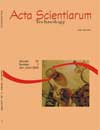<strong>Analysis of the use of a 0.2 µm ceramic membrane for beer clarification</strong> - DOI: 10.4025/actascitechnol.v30i2.5489
DOI:
https://doi.org/10.4025/actascitechnol.v30i2.5489Keywords:
membrane, ceramic, beer, microfiltration, foulingAbstract
This work compares the permeated flow and the quality of the obtained product in the process of beer clarification by crossflow microfiltration. The membrane used in the present study was a tubular ceramic membrane with a 0.2 µm nominal pore diameter, at 6 µ 1µC and 1, 2, 3 and 4 bar of pressure. Samples of the feed and permeate were analyzed. Additionally, the fouling mechanism was studied: complete, partial, internal blockade of pores and cake filtration. The results show a 28.75% reduction in color and 95.65% in turbidity at 4 bar. The study of fouling showed that the mechanism used for the pressures of 1 and 3 bar was the complete blockade of pores, whereas for the pressures of 2 and 4 bar, the cake formation was the mechanism used.Downloads
Download data is not yet available.
Downloads
Published
2008-10-20
How to Cite
Rodríguez Alicieo, T. V., Scolin Mendes, E., Curvelo Pereira, N., Davantel de Barros, S. T., Innocenti, D., & Alves, J. A. (2008). <strong>Analysis of the use of a 0.2 µm ceramic membrane for beer clarification</strong> - DOI: 10.4025/actascitechnol.v30i2.5489. Acta Scientiarum. Technology, 30(2), 181–186. https://doi.org/10.4025/actascitechnol.v30i2.5489
Issue
Section
Chemical Engineering
License
DECLARATION OF ORIGINALITY AND COPYRIGHTS
I Declare that current article is original and has not been submitted for publication, in part or in whole, to any other national or international journal.
The copyrights belong exclusively to the authors. Published content is licensed under Creative Commons Attribution 4.0 (CC BY 4.0) guidelines, which allows sharing (copy and distribution of the material in any medium or format) and adaptation (remix, transform, and build upon the material) for any purpose, even commercially, under the terms of attribution.
Read this link for further information on how to use CC BY 4.0 properly.











8.png)




